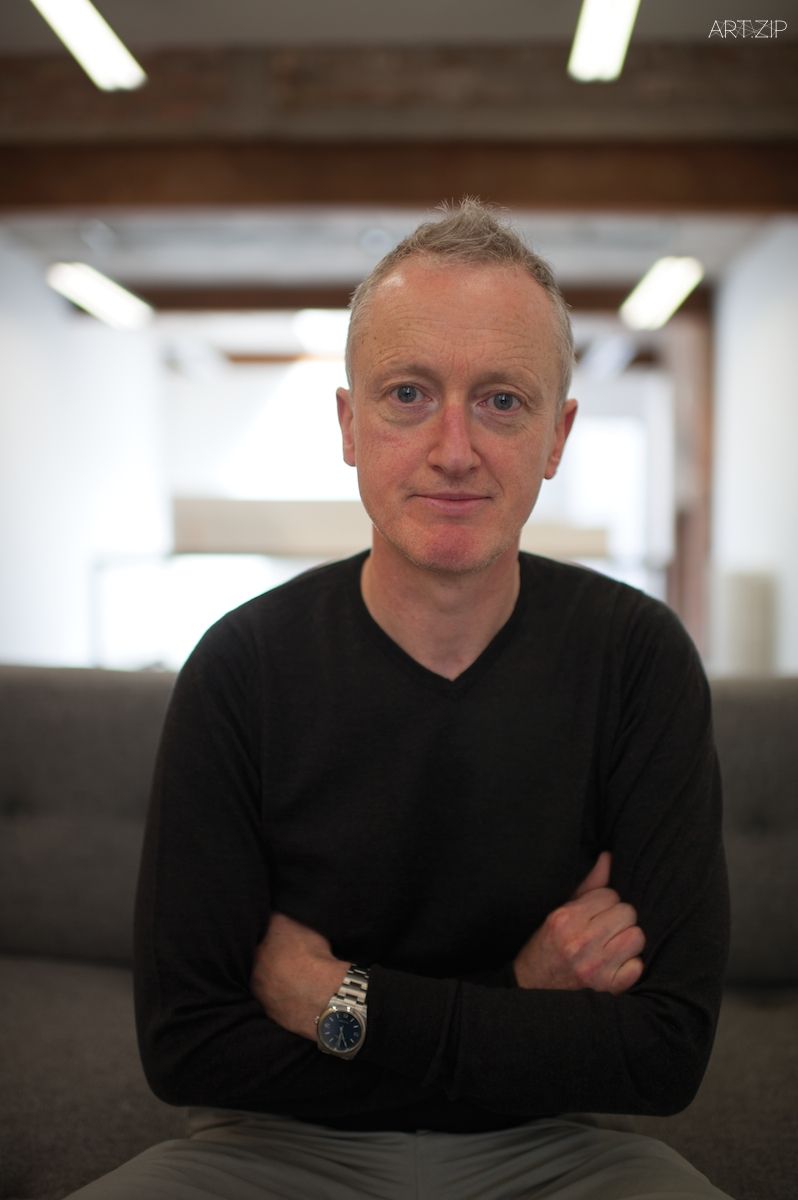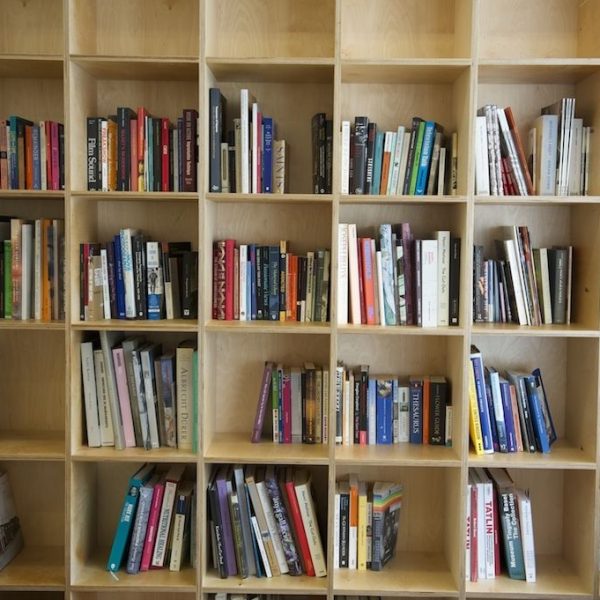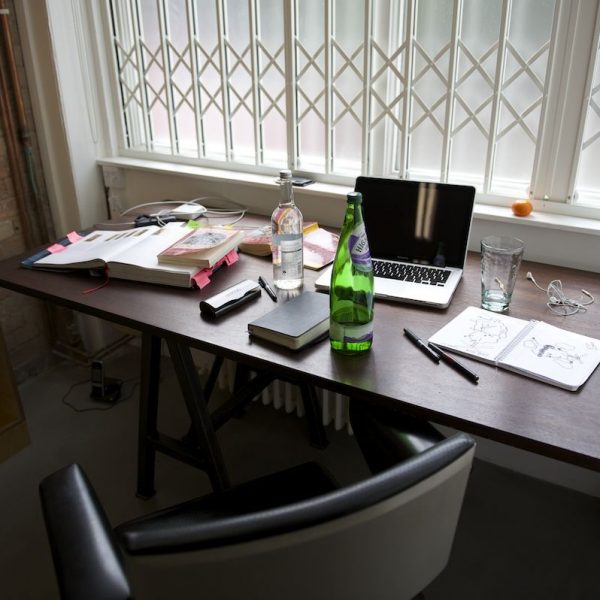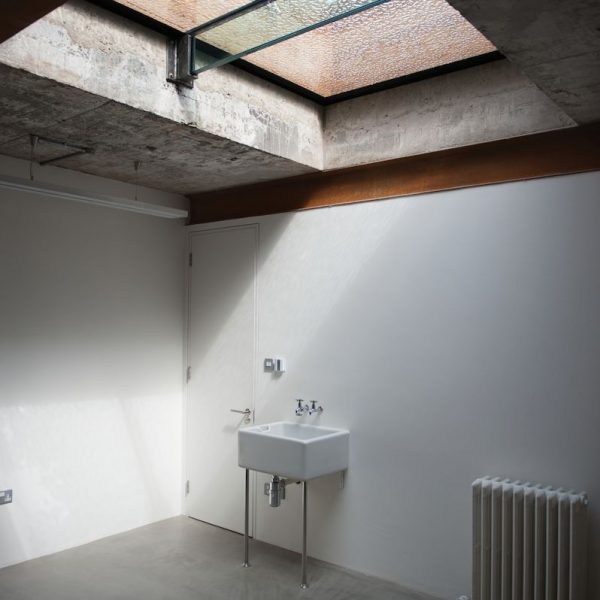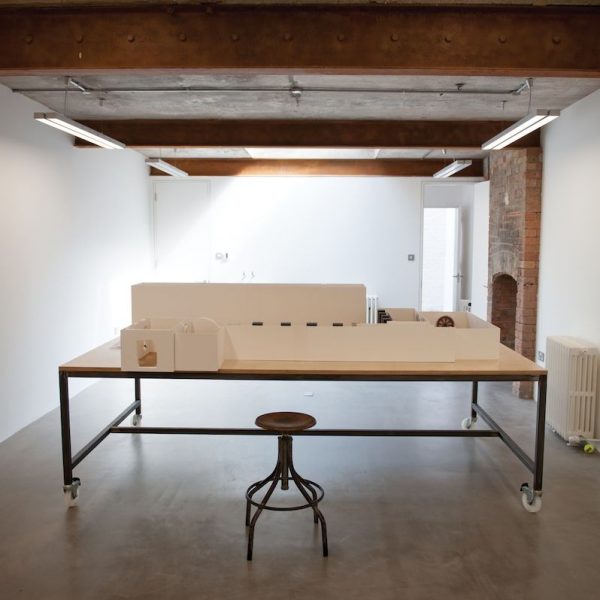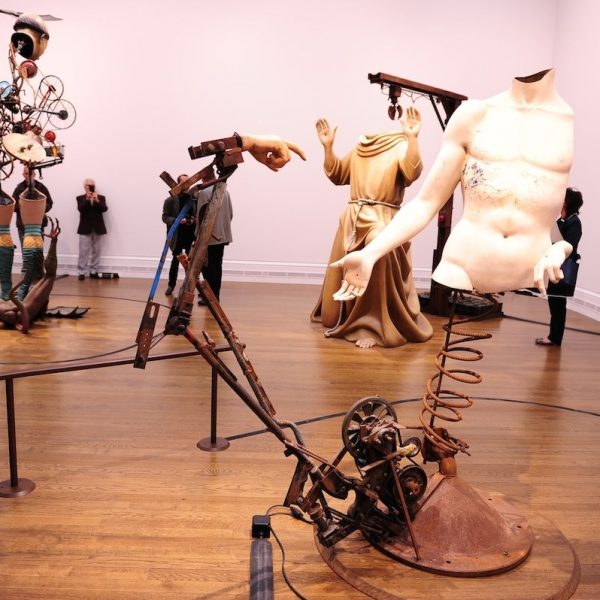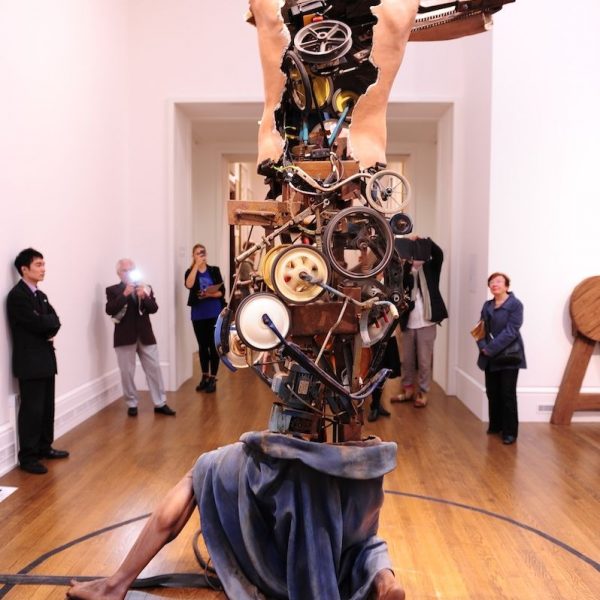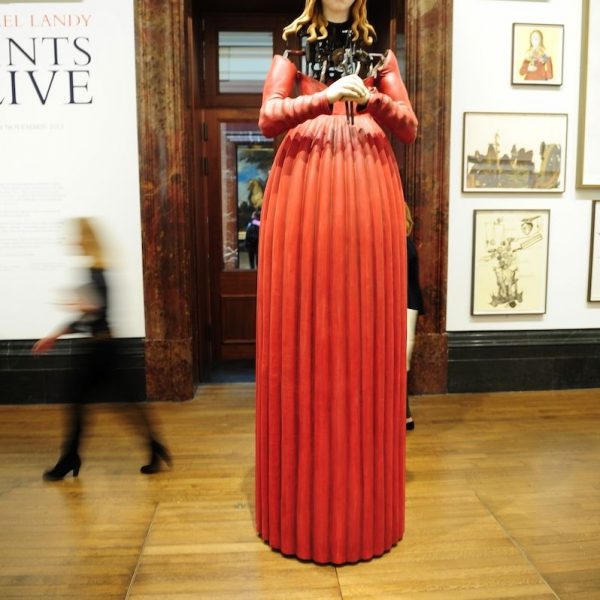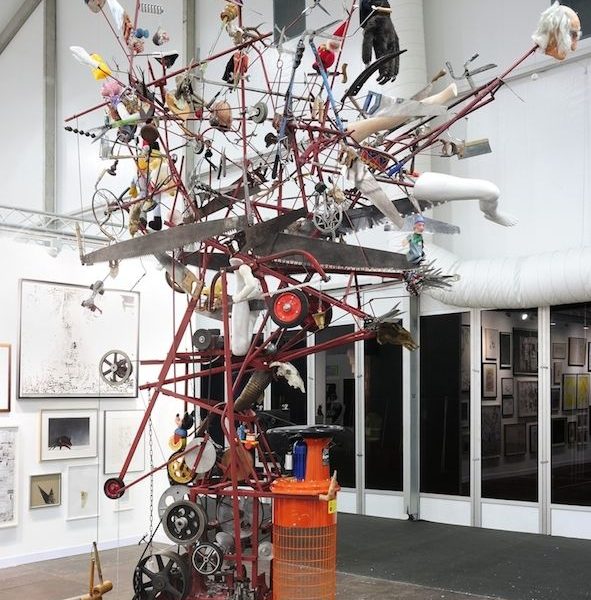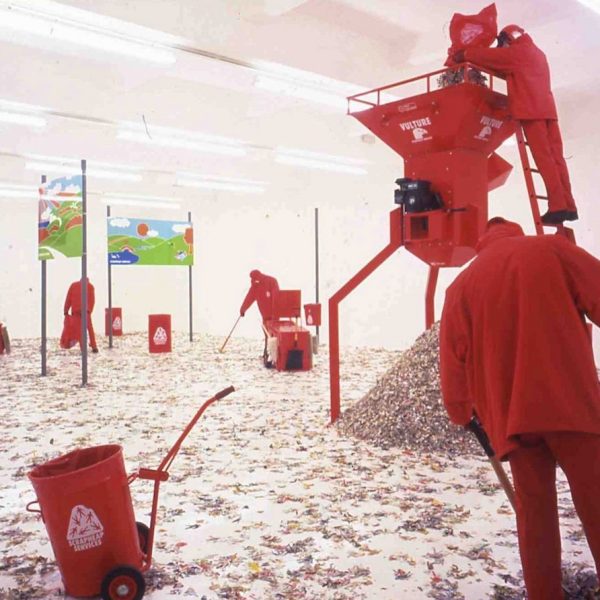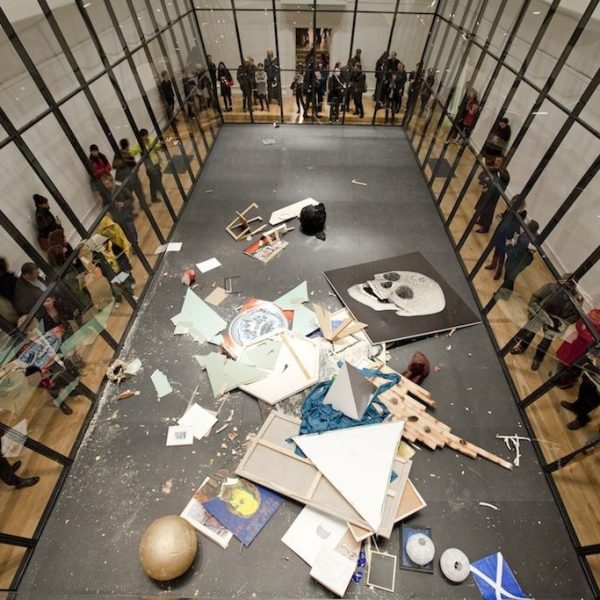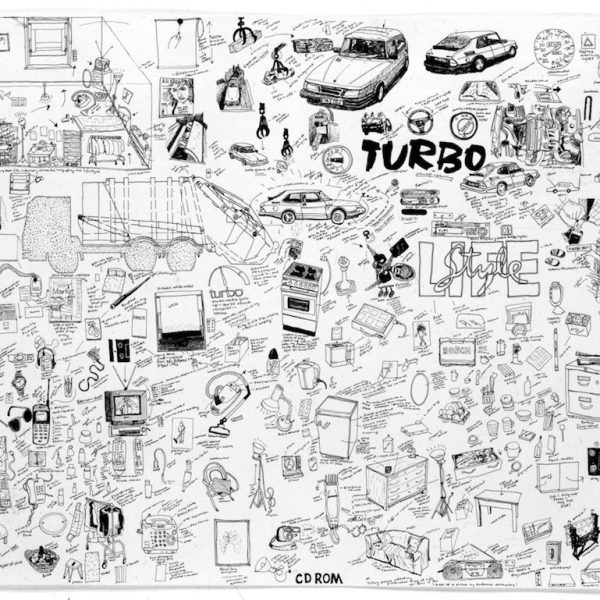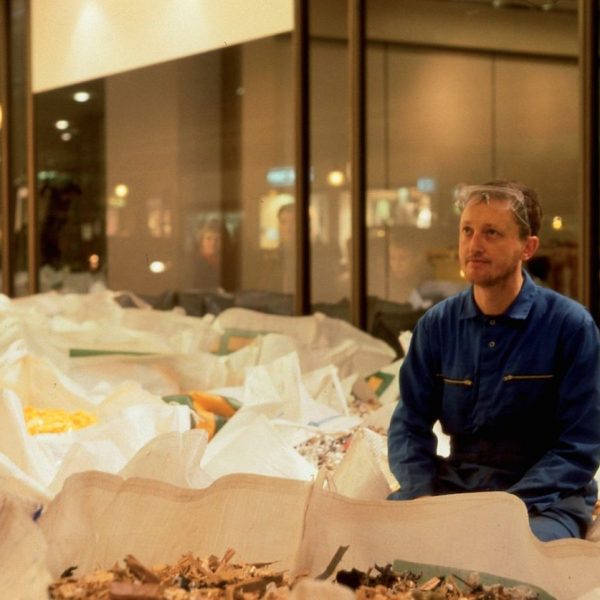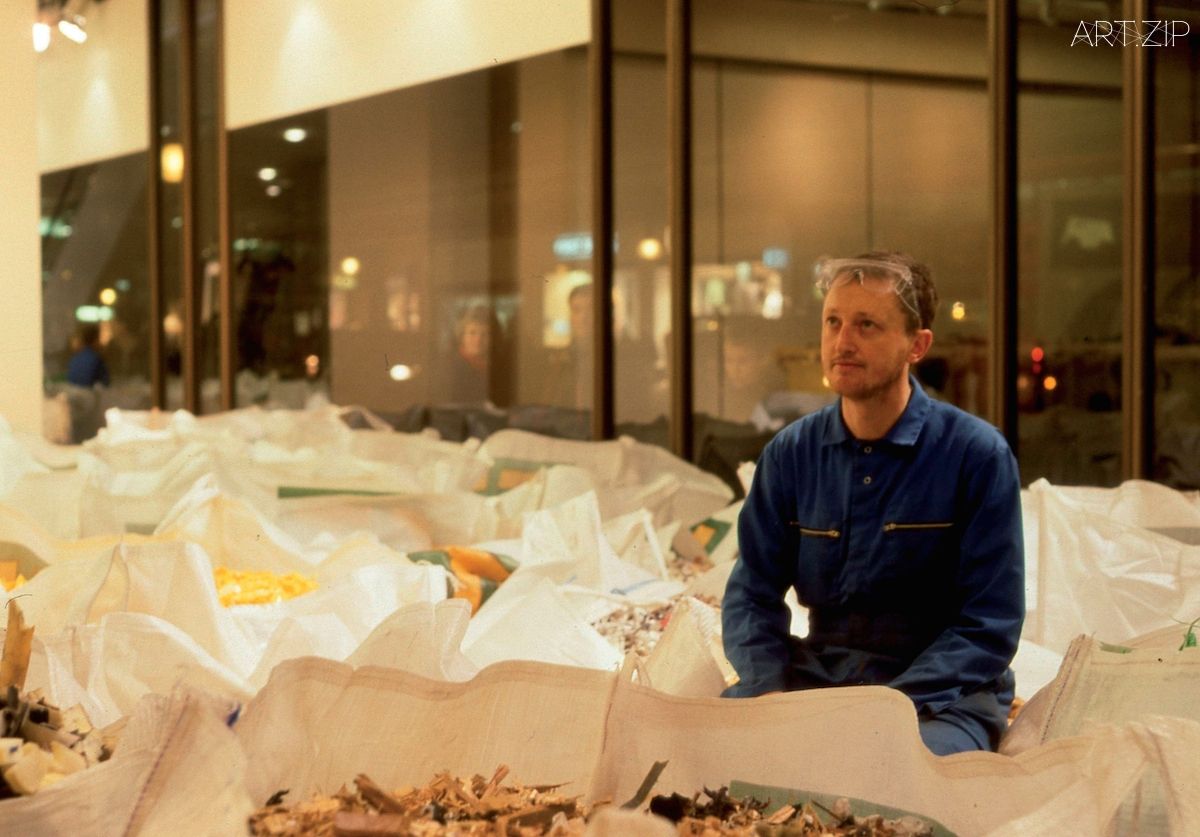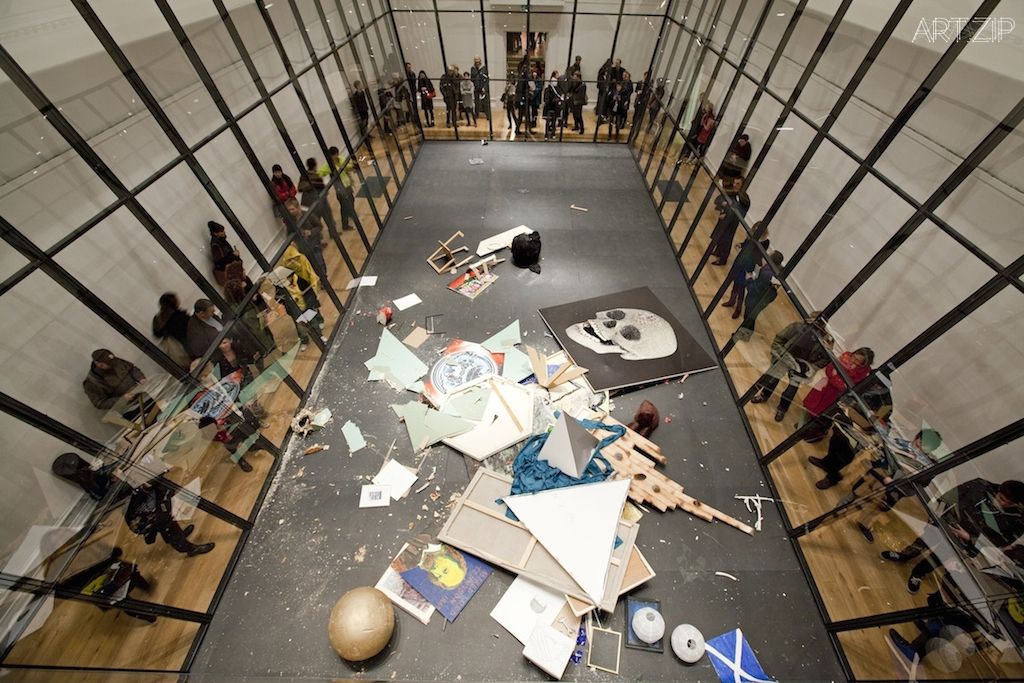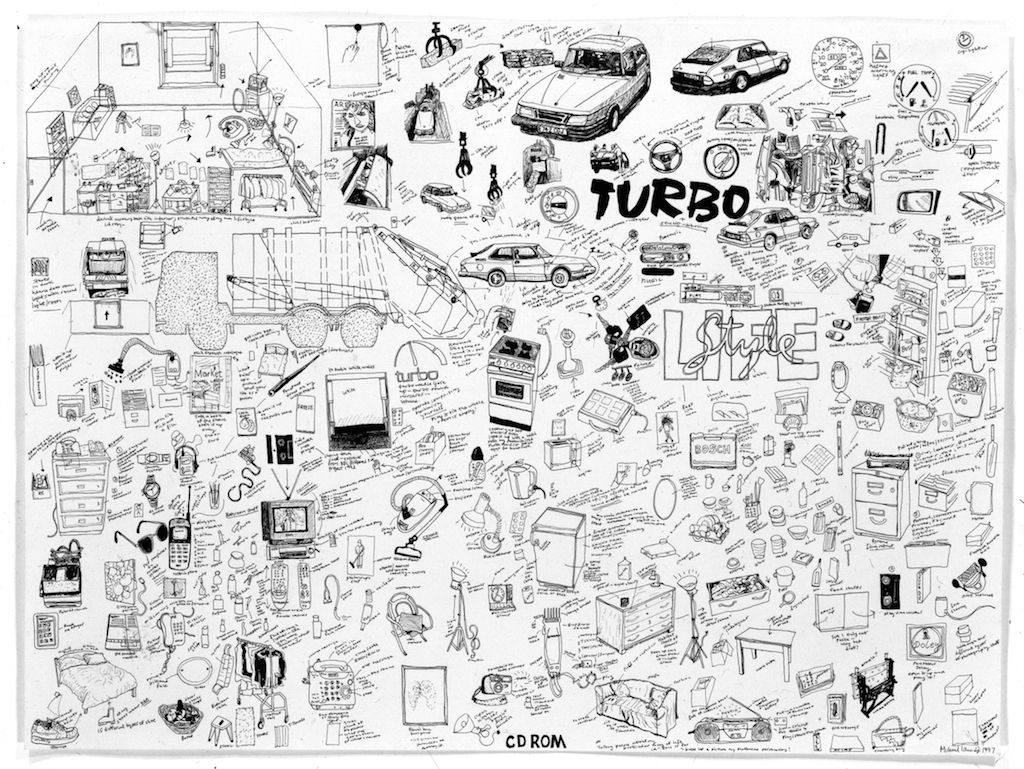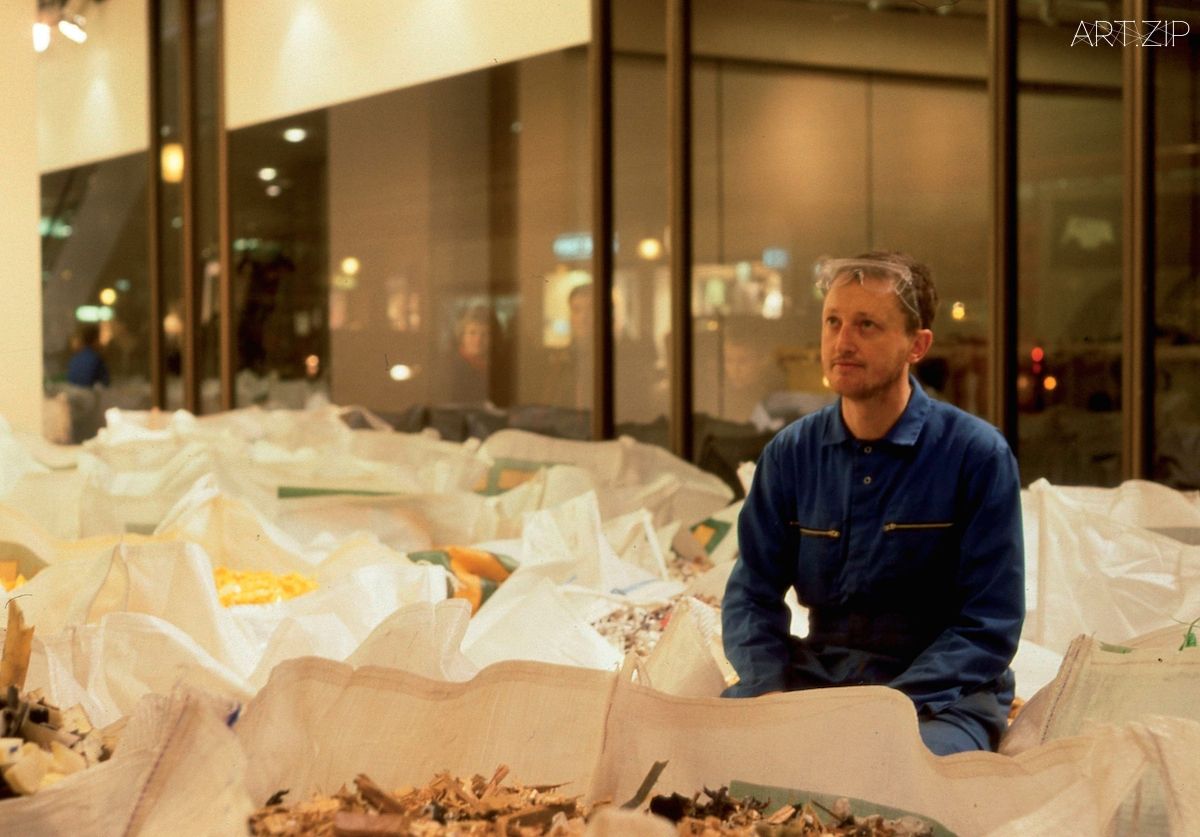
TEXT BY 撰文 x Anna McNay 安娜·麥克內
TRANSLATED BY 翻譯 x Bowen Li 李博文
IMAGE COURTESY BY 圖片提供 x the artist and Thomas Dane Gallery, London 邁克爾·蘭迪及托馬斯·戴恩倫敦畫廊
Michael Landy (born 1963, London) studied at Goldsmiths and is one of the so-called YBA (Young British Artists) generation, who took part in the first great artist-led warehouse exhibition, Freeze, alongside Damien Hirst, in 1988. He really made his name, however, in February 2001, when he systematically catalogued and destroyed all 7,227 of his personal belongings during a two-week long “performance” in a disused department store on Oxford Street, called Break Down. More recently, Acts of Kindness on the London Underground documented, as its titles suggests, kindly interactions between commuters and users of the transport system. Nowadays, Landy is, as he puts it, albeit very tongue in cheek, “all grown up”, having been elected not only as a Royal Academician, but also made Professor of Drawing at the Academy Schools. “Actually,” he laughs, “I’m just trying to find a way I can get thrown out of there, really. That’s what I’m thinking about at the moment.”
英國YBA當代藝術運動的重要成員邁克爾·蘭迪(Michael Landy)1963年生於倫敦,曾就讀於倫敦大學金史密斯學院。他也在1988年與達明安·赫斯特(Damien Hirst)等人一同參加了有里程碑意義的展覽《冰凍(Freeze)》。然而,他最為人稱道的作品是他在2001年2月完成的行為作品《崩潰(Break Down)》:在兩週時間內,蘭迪在牛津街一家空置的百貨商場內有系統地紀錄並銷毀了他所有7,227件個人物品。蘭迪近期的作品包括《善舉(Acts of Kindness)》,一個對倫敦地鐵系統內乘客之間友好互動的紀錄。蘭迪在最近被選為皇家美術學會院士,也成為了皇家美術學院的繪畫系教授。他半開玩笑地說,他“現在終於長大了”。“事實上,”他幽默地說,“我現在想的是要怎麼脫離這個體系。”
In October 2013, Landy moved in to a new studio in trendy Shoreditch. Just around the corner from Spitalfields fruit and vegetable market, the building is one of a whole line that used to be used as warehouse storage space. “You could actually walk between all of the buildings,” Landy explains, “but, at some point, someone decided to turn them into homes.” When he and his partner, fellow artist Gillian Wearing, bought the space, they had it gutted and built on a new top floor in which they now live. Landy describes it as a “live-work space”, although the studio remains very much just that, and is separate from their private quarters.
2012年十月,蘭迪在時髦的肖爾迪奇(Shoreditch)區購置了一間工作室。毗鄰斯畢塔菲爾德(Spitalfields)市集,這間工作室坐落於一系列連排房之中。他與同為藝術家的愛人吉莉安·崴爾玲(Gillian Wearing)把空間進行了清理和改造,現在居住於新完成的頂層公寓中。在工作區域與生活區域之間有着明確的分隔,蘭迪称其為“生活/工作空間”。
For an artist, who, in his student years used to squat in vacated buildings in South East London, having such a pristine studio space, as well as a second studio, which he mainly uses from drawing, in arts hub Vyner Street, Bethnal Green, must be quite a new experience. “When I left art college in the 1980s, the art world was a very different place from how it is today,” Landy says. “I went to college in South East London. You could find vacated buildings there, you could squat, you could find subsidised housing very cheaply. We used to literally bring the electricity in off the street. We’d get a kango and rig it up ourselves. That’s how we began – it was much more of a cooperative. It’s much more difficult now for young people, in a different way from how it was with us. For us, we had to deal with the British indifference towards the visual arts. But obviously now that’s all changed. I’d like to think that it was because of us.”
對於一個曾經在學生時期私自佔據於東南倫敦廢棄大樓內的藝術家來說,這樣的一個高檔整潔的工作室是一個全新的體驗(這已是蘭迪的第二間工作室。他的另一間工作室位於Vyner Street,那里聚集著許多藝術家工作室及畫廊)。“我畢業於上个世紀80年代,那時的氛圍與現在簡直是天壤之別。我就讀的學院位於倫敦東南,在那裡你可以輕易地佔據廢棄的大樓,也能找到很便宜的廉租房。為了省錢,我們曾經自己拿著重型器械把街上的電線接到公寓里。我們就是那樣開始的--互相幫助,自力更生。現在的年輕一代很不容易,面臨著非常不同的狀況。對於我這一代來說,我們要面對的是大眾對於視覺藝術的漠不關心。我傾向於相信因為我們曾經做出的貢獻,現在的狀況很不一樣了。”
Indeed, the YBAs are responsible for a seismic shift in art consumption – and, as a knock on effect, no doubt, art production. “I remember, when we were at college, we were actually very naïve,” Landy continues. “We didn’t know how to promote ourselves. But then you see the generations that come after you become more and more knowledgeable. We just kind of made it up as we went along. There was no master plan or anything. Nowadays it’s all about the commodification of art. Galleries are getting bigger spaces and then artists have to fill those spaces, so obviously the whole production thing has to get to a whole new level as well.”
YBA運動的確對藝術生產以及消費造成了深遠的影響。“在學生時代,我們非常幼稚。我們不知道如何去推銷自己。但可以看到,新一代藝術家們更懂得這些事情。我這一代摸著石頭過河,並沒有甚麼宏偉的計劃。現在,一切都是關於藝術的商品化。畫廊空間越來越大,藝術家們必須填滿這些空間,所以顯而易見地,藝術生產達到了一個新的高度。”
Talking of filling spaces, Landy’s studio is starkly empty, apart from a bookshelf, a desk, and a couple of tables with scale models of the museum in Mexico where his exhibition, Saints Alive, which was the culmination of his residency at London’s National Gallery last year, is soon to be restaged. Landy is extremely apologetic, almost ashamedly so, for the lack of typical artist’s mess. “I am an artist though!” he hastens to add, as if a messy studio were somehow a compulsory identifier.
說到“填滿空間”,反觀蘭迪的工作室卻是驚人地空蕩蕩。除了一個書架,一個辦公桌以及几張桌子之外,這裡空無一物。桌子上擺放著一家墨西哥美術館的模型,蘭迪將在這個美術館中再次展出去年他在倫敦國家美術館完成的展覽《聖者永生(Saints Alive)》。蘭迪為他工作室不尋常的整潔空蕩感到抱歉,他還半開玩笑地趕緊補充說“我真的是个藝術家!”似乎,一個藝術家的工作室本應是凌亂、擁擠的。
Landy likes to visit other artists’ studios, in fact. “Seeing other artists’ studios interests me because it’s an insight into the way they work, and some of it is quite intuitive and spontaneous. They’re really messy, though,” he adds, quite matter of factly. Take, for example, Ian Davenport. “We went to college together and we used to live together. He’s a painter, so he used to have paint on him everywhere. He’d come in from the studio and he’d have got it in the car somehow and so it would transfer into the flat.” Then there’s Gary Hume, another YBA, who has his studio just up the road. “He’s another painter, so it’s much more hands on, making things, which obviously intrigues me, but I don’t do that myself. I’m sure they get some kind of satisfaction out of it, though. Maybe I should try!”
事實上,蘭迪非常喜歡去拜訪其他藝術家的工作室。“我對別人的工作室很感興趣,因為我能通過這些了解他們的工作方式,並意識到有時候藝術家們以非常隨意的方式工作。然而他們的工作室真的很亂。我與伊恩·達文波特(Ian Davenport)是同學,也曾經住在一起。他是一名畫家,那時他滿身都是油彩。他從工作室出來,把這些油彩帶到車裡,再帶到公寓里來。”另一位YBA運動成員加里·休姆(Gary Hume)也是如此,蘭迪補充道:“他也是一名畫家,所以他在創作時經常需要親自動手。這非常吸引我,雖然我並不會這樣做。我想,他們在創作的時候一定非常有滿足感。我或許也應該試試!”
For Landy, the emptiness in his studio is, he suggests, symbolic of the emptiness in his head. At the moment, at least. “One minute it’s full of stuff and the next minute I’m wandering around thinking ‘What am I going to do next?’ And this is the moment you’ve found me in, the moment where I’m not sure what I’m doing. Hence the emptiness. It’s not fun being me at the moment, but if I think about it a lot, I panic.” His work goes through cycles. Currently he is looking back on old pieces he might rekindle. As well as Saints Alive in Mexico, he is also recreating Art Bin for the Yokohama Triennale and is hoping to stage an Acts of Kindness project in Athens.
對於蘭迪來說,工作室的空無象徵著當下他頭腦中的空無。“在這一刻,我腦子里滿是事情,下一刻我又在想,我現在應該去做些甚麼呢?你現在看到的是這樣的我,充滿著不確定的我。這就是為甚麼工作室是空蕩蕩的。現在的我一點也不好玩,但是我經常思考這件事,甚至有些慌張。”他的作品似乎都在經歷著某種循環。目前,他正在回顧過去的作品:除了《聖者永生》在墨西哥的展覽之外,他也將為橫濱三年展重新製作《藝術垃圾桶(Art Bin)》,並希望在雅典創作另一个版本的《善舉》。
“I always start with an empty space,” he explains. “I like that. It partly dates back to when I destroyed all of my worldly belongings. Once you do that, you become very aware of what you have in a space and what you don’t. Before, when I had studios, I just had junk and all sorts of stuff in there and I didn’t really think about it too much. But once I got rid of all of that, ever since, it’s always been like this, where I don’t really like having lots of things around me.”
“我的創作總是從一個空無的空間開始,我喜歡這樣的開始。某程度上,這總與我毀掉我所有的個人物品有關。一旦你做出了這樣的事情,你就能夠確認在一個空間之中你的身外之物都是些甚麼。從前,我在工作室之中堆滿了各種垃圾,而我從未認真考慮過這件事。然而,一旦我捨棄了所有這些事物,我就馬上習慣了這樣的狀態,直到現在。”
Not that he objects to clutter, per se. “I love clutter, just somebody else’s clutter, not my own. I like to think that I have to reimagine myself – not being too pretentious about it – and ask myself what else I want to do. I was reading about Marina Abramović always trying to distil everything down and I think that’s what I’m trying to get to. I am a hermit. I don’t go to the Syrian desert, but I do have to detach myself from the world to a certain extent. I’m not spiritual though. When I destroyed all of my worldly belongings, people obviously said that you could read a spiritual element into it, but I’m not spiritual.”
儘管如此,他並不反對大量物件的堆積。“我喜歡物品凌亂地堆放在一起,只是自己不會這麼做。我傾向於這樣去想:我必須重新想像我自己--不做作地去重新想像自己--並詢問我自己,还有甚麼是我想做的。我最近讀到,瑪麗娜·阿布拉莫維奇(Marina Abramovic)總試圖去蕪存菁,而這也是我想做的。我是一名隱士。我不會跑到敘利亞沙漠與世界隔絕,但是我也在嘗試與世界保持一定的距離。我並沒有宗教信仰。我在毀掉所有身外物的時候,人們常說這有某種宗教意味在這行為裡面,但其實我並沒有宗教信仰。”
Landy’s studio is a very private space. He doesn’t have assistants either. “I once interviewed someone to be my assistant and then I thought ‘What am I going to do with them?’ Do you know what I mean? If they were here now, I’d be thinking ‘Oh my god’ and I think I’d actually end up working for them. I’d become their slaves.”
Even as a child, Landy, who got nicknamed “Blandy” at art college because of his reticence to speak, didn’t like collaborating. “If people used to paint on my area, I’d say ‘No, you can’t do that!’” In the meantime, obviously, he has had to learn to collaborate with people on specific projects and even to take on assistants now and again, but, generally, he prefers to be alone. “Having someone here, at moments like this, it’d be horrible. And also they rely on you to make a living, so no, it’s too much responsibility. I don’t even really want to be responsible for myself, to be honest.”
蘭迪的工作室是一個非常個人的空間,他也沒有雇傭任何助理。“曾經有一次在面試助理的時候,我想:我要拿他們怎麼辦呢?你明白我的意思嗎?如果他們現在在這兒,我會瘋的。我也會想,估計我會變成他們的奴隸,為他們工作。”
在年少時,蘭迪就因為沈默寡言、不合群而被同學們取笑。“如果同學們在做畫的時候闖入到我的空間里來,我會很認真地拒絕:‘不,你不能這麼做!’”當然,他與人合作也常常需要助手的協助,但一般來說,他傾向於獨處。“現階段,有別的甚麼人在這裡工作是一件糟糕的事情。他們也指望著你來生存,所以我不會這麼做,這个責任太大了。說實話,我都不想為自己負責。”
Landy does try to visit his studio daily, largely enabled by living upstairs, but this is, admittedly, “only unless I can find something else to do!” He has no specific routine to speak of. “That’s the terrible thing, in a way, because then I have to create my own routine, I have to create myself, basically. Every day, when I come here, I have to think about what I’m going to do. And the worst bit, actually, is just sitting down and forcing myself to do it, because I get really distracted. But that’s it, isn’t it? It’s just me and it in the end and no one else cares. It’s always been a struggle. This is very typical for me. I go through cycles of being very productive and then not being very productive. That’s how it’s always been. And this is the worst bit, when you don’t quite know what you’re doing.
There once was a gallery that said they couldn’t make any financial sense out of me. If it were left up to me, if I were left to my own devices, the whole art world would be over by now. There’d be empty art fairs and empty galleries everywhere. I’m not playing the game very well. I’m not a very productive artist, basically. But that’s the way I want it. I’m happy being like that.”
蘭迪嘗試每日在工作室內工作--無論如何,他就住在工作室樓上--他打趣地說:“只有當我沒有別的事可做的時候才會去工作室!”他並沒有一個特定的工作時間。“這挺糟糕的,因為我要為自己創造規律,說白了,就是創造我自己。每一天,當我來到工作室,我就要思考我要做些甚麼。事實上,最糟糕的事是強迫我自己去做些甚麼,因為我很容易走神。但是,本來就是這樣的,不是嗎?到頭來,這一切與別的任何人無關。我一直在掙扎,這對我來說是家常便飯。我有時非常有效率,有時沒那麼有效率,週而復始。我一直是這樣創作的。而當你不知道做甚麼好的時候,那是最糟糕的。”
“有一家畫廊曾對我說,他們不能在我身上賺到任何錢。如果我能選擇,如果我能按著我的喜好創作,整個藝術界現在就不存在了。全世界都將充滿著空蕩蕩的藝術博覽會和空蕩蕩的畫廊。我不是很擅長玩藝術與金錢的遊戲,基本上,我不是一個非常高產的藝術家。但這是我想要的,我也因此而高興。”
Where does Landy draw his inspiration from, faced, quite literally, with a blank canvas? “I refer to some books, I read, and then my mind starts to wander. Most artists have postcards on the wall, or stuff to inspire them, but I can’t be bothered with that. I don’t have those kind of references, I usually chuck them out. I do have sketchbooks, though, and I write ideas in books.”
When Landy did his residency at the National Gallery, he had to derive his work from the collection, as that was his remit. “I wanted to engage the public, physically, very differently from when you look at a painting. Saints have such fabulous stories. There’s a lot of flagellation in Renaissance art. I was brought up Irish Catholic, so I could really relate to this. Irish Catholicism is all about beating yourself up. I’ve always had a slightly destructive bent to my art too.”
對著空白的畫布,蘭迪的靈感來源是甚麼呢?“我從書中獲得靈感,閱讀,然後我的想法開始擴散。很多藝術家在牆上放滿明信片或諸如此類的事物以獲得靈感,但我不想這麼做。我沒有這種具體的靈感來源,我往往把這些東西扔了。然而我还會使用草稿簿,並常記錄下自己的想法。”
蘭迪在參加倫敦國家美術館的藝術家進駐項目時被要求以館藏為基礎創作個人作品。“我希望直接地與公眾交流,而不僅是盯著畫作看。聖人們有着那麼奇妙的故事。文藝復興藝術中有大量的鞭刑場景。我來自於一個愛爾蘭天主教背景的家庭,所以我能夠感同身受。愛爾蘭天主教的一切都與揍自己一頓有關。我的藝術中也常有這種自我毀滅傾向。”
Landy’s studio space really is more of an office space, a drawing board space, a space for birthing ideas. “It’s probably a place to go. I wouldn’t want to go to a coffee shop,” he admits. “I’m often sat there scribbling away about ideas, reading a bit, and writing things down.” Landy’s actual works are generally produced off site by artisans whom he commissions for their specific skills. “I don’t make things by hand, on the whole. My drawings I do, but not my sculptures. I normally have the idea first and then think about it a lot and find people to go and execute it. I’m quite happy on a kitchen table, most of the time. I don’t need a lot of space. I just have space, but I don’t actually need it. I think the studio is a millstone around my neck, really. It is a paradox.”
Given his destructive bent, and his lack of studio requirements, I wonder why Landy has never considered destroying his studio. “I never got as far as to destroy the studio itself,” he says, “because I never owned the studio.” Well, he does own it now, so who knows what might happen? It seems as though there’s no need to anticipate further destruction, however. “I always say to Gillian that we should rent it out.” I remind him that he has two spaces. Will he maybe let one go? “No, no. I’ll keep both. I like buying empty spaces. That’s what people are complaining about in London, aren’t they? That lots of foreigners are coming over and buying flats and just leaving them empty. And I’m just doing the same.” Not quite, Michael, not quite. Your studio spaces may be physically empty, but, like your head, they are, I am sure, full of ideas; ideas which we look forward to seeing come to fruition.
蘭迪的工作室更像是一個辦公室,一個孕育想法的空間。“這裡就是一個我可以去的地方,我不想去一個咖啡館之類的場所。在工作室中,我常記下一些想法、閱讀,再進行一些寫作。”蘭迪的實體作品經常是委託工廠在倫敦以外的地方完成的。“一般來說,我不動手製作。我自己完成繪畫,但是不會親自完成雕塑。我一般的工作方式是:我先構建一個想法,大量地思考並完善這個想法,再找人來執行這個想法。在一個桌案上工作我就已經很滿意了。我不需要很大的創作空間。我所擁有的只有空間,然而我並不真的需要這空間。我覺得工作室是一個負擔。這聽起來很矛盾吧。”
我不禁好奇,為甚麼這樣的一位有毀滅傾向的、不需要工作室空間的藝術家,沒有考慮毀掉他自己的工作室。“我還沒想過要毀掉自己的工作室,我還沒那麼極端,因為我以前從來沒有真正擁有過一個工作室。”不過,現在他已經擁有這個工作室了,誰知道接下來會發生甚麼呢?似乎接下來也不需要他再做更多的“毀壞”類型的作品了。“我常對吉莉安說我們應該把這裡租出去。”我提醒蘭迪他現在已經擁有兩個工作室了。他會捨棄其中一個嗎?“不,不。我兩個都留著。我喜歡買空蕩蕩的空間。這也是倫敦人一直在抱怨的事,大量外國人前來購置公寓,交易完成了就離開,使這些公寓變成了空置房。我居然也在做同樣的事。” 邁克爾,你和他們还不太一樣。你的工作室看起來是空的,但我相信它就像你的腦子一樣,裡面充滿了各種奇思妙想,而我們正期待這些想法可以慢慢實現。

